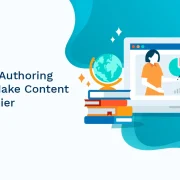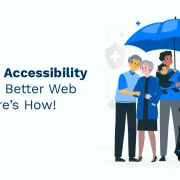
7 Ways to Use Interactive Videos in eLearning for K12 Students
The trend of watching online videos to learn and understand topics has grown exponentially in the last few years, with the worldwide average touching the 40.4% mark in 2024.
Due to such an impactful reach, almost all industries have started incorporating videos for learning and development purposes. The education industry is no different, given its natural scope to adopt this technology.
Interactive videos for education are among the most frequently used and reliable teaching aids in today’s virtual learning environment. They ensure effective and efficient learning for both students and teachers.
In this blog, we explore some key benefits of interactive videos, their applications, and how they can be used specifically in eLearning for K12 students.
Table of Contents:
- Why Do Interactive Videos Work for K12 Students?
- Successful Applications of Interactive Videos
- Seven Ways to Use Interactive Videos in eLearning for K12 Students
- In Conclusion
Why Do Interactive Videos Work for K12 Students?
Here’s why more and more K12 students and their instructors prefer using
1. Immersive and Engaging Learning
Students today continuously interact with the ever-changing digital ecosystem. Interactive materials like clickable quizzes, choose-your-own-adventure-style choices, and fun feedback keep students actively engaged with the material.
On a similar note, interactive videos are very immersive and are specifically designed to be engaging. Given that learners can be inconsistent at times, especially K12 students who have shorter attention spans, they are designed in a creative and captivating style to catch their attention and motivate them to watch and learn.
2. Improved Retention and Understanding
Active learning is a prime example of better memory retention for kids. Students show more inclination towards interactive, clickable content than passively watching a video.
3. Personalized Learning Paths
Interactive videos allow students the breathing space required to absorb course content. They are designed to offer branching, a feature that can take different learning paths based on the student’s choices or responses, and offer a suitable learning course for every learner.
4. Supports a Variety of Learning Styles
Students have their own ways of learning. Some prefer visual learning, while some are better at understanding auditory explanations.
Interactive videos let students choose from multiple learning styles, harboring a healthy learning ecosystem. They further provide K12 students with a certain sense of user control, allowing learners to design their own virtual learning environment and experience. This enables students to watch and learn at their own pace without any external pressure.
5. Convenience and Flexibility
Besides the benefits mentioned above, interactive videos also offer great convenience to students and teachers. This is simply because they can be delivered virtually and are perfect for online and blended learning.
Also Read: Future-Proof Your Curriculum: Using AI in Education for Student Learning
Successful Applications of Interactive Videos
Some examples of successful applications of using interactive videos in K12 classrooms are:
- Flipped Classrooms: In flipped classrooms, students have the flexibility of watching video lessons at home and later participating in interactive workshops in class. By making the learning content easy to understand and interactive, educators make certain all students are actively engaged in the course content.
- Test Preparations and Review: Interactive videos help students prepare for tests. With embedded quizzes and decision-making exercises, students can keep practicing and review their performances in a test-like scenario.
- Real-time Analytics for Teachers: Several platforms that support interactive videos enable teachers to use real-time analytics during online lessons. Teachers have access to all student’s performances and what they’re struggling with. This helps them personalize teaching methods for each student.
Seven Ways to Use Interactive Videos in eLearning for K12 Students
Take a look at the seven ways you could introduce interactive video for eLearning purposes of K12 students:
1. Creating a Series of Video Clips
One of the best ways to use interactive videos and increase student engagement is by incorporating classroom videos in lesson plans. As an educator, you can plan your lesson around 2-6 video clips. These could either be relevant YouTube videos, videos that you have created, or previously used videos from other educators.
After you have presented the video clip to your class, you can then plan various interactive exercises, such as self-reflection, guided questions, or group discussions, to discuss the topic in detail. The idea here is to use several video clips related to a particular topic to enhance students’ understanding.
2. Making Tutorials and How-to Videos
Another interesting way to use interactive videos in eLearning is by asking students to create detailed how-to videos.
For instance, you can ask your students to explain the concept of fractions or the process of photosynthesis. Students can do this on a whiteboard app, record their desktop screen as they do, and share it with teachers and peers. These how-to videos are an excellent way to help you assess the learners and give feedback.
3. Lesson Recaps
To ensure that every student pays attention in class, you can ask them to make/record a brief video recap of the lesson learned on a particular day.
Encourage students to present their learning creatively and concisely, and have them submit their videos via email, Google Classroom, or whichever mode is convenient.
Video recaps are an excellent way to assess student understanding of the concept and whether you need to revisit any specific topic before moving on to the next one.
4. Conducting Q&A Sessions
You can also let your students record their responses to a series of questions after watching an interactive video in class.
For instance, as your students watch and engage in an educational video, you can create a set of questions related to the topic. Students can answer these questions and send you a video response.
5. Keeping a Tab on Student Performance
Interactive videos can also be used to keep track of student’s performance and share it with them later. Some platforms allow monitoring user analytics, wherein the instructors can view students’ progress through every content.
Instructors can get information about where exactly students have stopped watching or are having difficulty processing information, and which part they keep going back to.
Leveraging this kind of interactive video analytics helps you understand what interests students and which parts of the video require more explanation.
6. Reflection
Yet another exciting video teaching strategy educators can leverage is to use some of the most powerful videos from YouTube or similar sites and get their students to reflect on them. It helps students develop their critical thinking skills and apply them in real life. This learning strategy has become quite popular in recent years.
However, it is important to remember here that the idea is not to let students simply consume the video and its content but to reflect on it at a deeper level. This means encouraging them to engage with the content emotionally and reflect on what they are watching and understanding out of it.
To be able to grade this assignment, you can either have students do a quick group discussion sharing their thoughts, write an exit ticket, or have interested students share their reflections on what they have seen.
7. Bring Students Together for Collaborative Projects
Collaborative learning allows students to brainstorm along with their peers. This exercise helps build leadership skills and critical thinking skills in students.
Teachers can bring together students in small groups to plan and co-create a video project as a team. They can either create videos, record meetings, or simply upload audio files or pictures to complete the project. Delivering interactive videos is an easy and excellent way to make learning more engaging and fun for K12 students.
Also Read: Why EdTech Security is the Need of the Hour in K12 Education?
In Conclusion
Using the strategies discussed above, you can maximize the impact of interactive videos in K12 classrooms and ensure that they serve as excellent teaching aids for teachers and students to connect and inspire each other.
If you wish to upgrade your K12 learning platform with smooth video solutions, Hurix Digital helps you achieve interactive and personalized educational content.
Contact us now to learn how to leverage interactive videos for optimal eLearning results.

Senior Vice President – Business Development
at Hurix Digital, with over 25 years of experience in EdTech and workforce learning. He excels in business development, customer relationship management, and scaling digital learning solutions, driving global growth through innovative content, simulations, and AI‑driven training offerings




